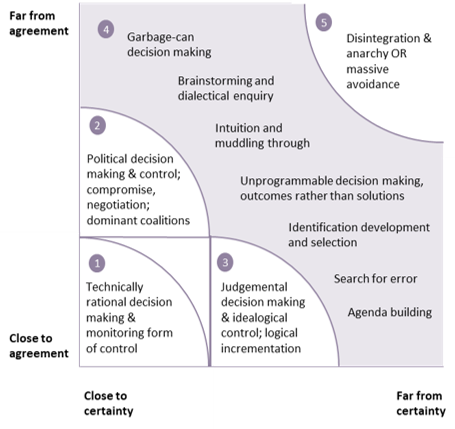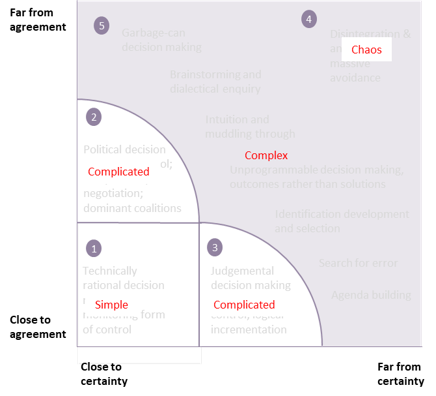The Stacey Matrix1 was developed and published by Ralph Douglas Stacey. It is designed to help understand the factors that contribute to complexity and choose the best management actions to address different degrees of complexity. It was not specifically designed to address project delivery but is just as relevant to that area as any other.
The basis of the matrix is two dimensions: agreement and certainty.
Projects are close to certainty when cause and effect relationships are well known and similar projects have been performed in the past. It is then usually possible to extrapolate from past experience to predict the outcome of a new project. Techniques such as parametric and analogous estimating depend upon this information.
Projects that are far from certainty are required to deliver something that is new and innovative (or at least new to the host organisation performing the project). Often, cause and effect relationships are unclear. Past experience is of little help when trying to plan.
Members of a group, team or organisation will have differing views on the objectives of the project and how to achieve them. The governance, management style and approach to managing the project will depend upon the level of agreement.
Within the two axes, Stacey identified five areas:

1. Close to agreement, close to certainty
-
In this area of the matrix, data can be gathered from the past that can be used to predict the future. Construction and engineering projects typically have a wealth of technical data that allows them to be well specified and scheduled before delivery work starts. Work is controlled by monitoring against detailed plans.
2. Far from agreement, close to certainty
-
Some projects are very certain about which objectives are possible and how they can be delivered but there is less agreement about which objectives are of greatest value. This may be exemplified by a project manager who has trouble developing a business case that is acceptable to multiple stakeholders who have differing views on value.
-
In this area, skills such as negotiation, reaching a compromise and developing coalitions are important. Decision making becomes political rather than technical.
3. Close to agreement, far from certainty
-
Projects may have a high level of agreement about the desired objectives but not much certainty about the cause and effect linkages that will result in the desired objectives. Relationships between outputs, outcomes and benefits can often fall into this category when assumptions are made about how outputs will lead to benefits.
-
In cases like this a strong sense of shared vision among the stakeholders is necessary and a flexible and realistic approach to planning. The project manager and sponsor must visibly head towards an agreed future state (blueprint) even though specific paths are not fully predetermined.
4. The zone of complexity
-
This zone covers an area where the combination of low levels agreement or low levels of certainty make the project a complex management problem. This is the area that often triggers poor decision-making practices, when what it really needs are high levels of creativity, innovation and freedom from past constraints to create new solutions.
-
Adaptability and agility are key skills here, not just for the project manager but for the sponsor, team members and stakeholders. Approaches such as Concurrent Engineering and Systems Thinking are useful here.
5. Far from agreement, far from certainty
-
Where there is little agreement and little certainty, anarchy can prevail. Individuals and organisations sometimes resort to avoidance but such situations cannot always be avoided. Strategies are needed to address these situations should they occur.
-
This zone is often referred to as chaos rather than anarchy and the boundary between this and the zone of complexity is known as the ‘Edge of chaos’.
The Stacey matrix has a lot on common with other complexity-based models. For example, a project in Zone 1 is arguably the same as a Type A project in the WHOW model. Similarly, Zone 2 projects in this model are similar to Type B and so on.
Another related framework is the Cynefin Framework which helps understand the way to respond to circumstances around simple, complicated, complex and chaotic circumstances. How these four areas relate to the Stacey Matrix is shown below:

- Stacey RD. Strategic management and organisational dynamics: the challenge of complexity. 3rd ed. Harlow: Prentice Hall, 2002.






